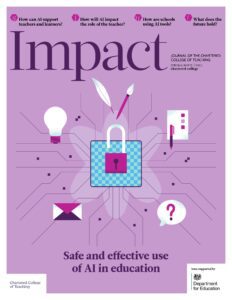Do pupils dream of electric teachers? Secondary school pupil perspectives on AI and the implications for teacher professionalism

JAMES LEIGH, HOUSEMASTER, CANFORD SCHOOL, UK
Introduction
The educational landscape is rapidly evolving, with so-called artificial intelligence (AI) emerging as a potential game-changer. Easy-to-access large language models (LLMs), such as ChatGPT, Gemini and Copilot, are particularly intriguing, holding the promise of personalised learning paths, efficient research assistance and potentially even automated assessment. However, the potential impact of such technology on the very heart of education – the human teacher – remains a critical question, and there are many ‘solutions’ being sold that promise to provide interactive tutoring and allow greater academic progress than in-person learning in the classroom. While there are some benefits to this in terms of the well-reported issues around teacher recruitment and retention, the potential ramifications to the wellbeing of young people must be considered.
This study explored the perspectives of secondary school pupils on the use of LLMs in education in an independent day setting. The aim was to understand their experiences and thoughts on the use of LLMs and consider the implications to teachers. By understanding their experiences and preferences, we can gain valuable insights into how to shape the future of AI integration in the classroom, while ensuring that teacher professionalism remains paramount.
Methodology
A survey was distributed to 349 pupils across Years 8, 10 and 12 within an independent secondary day school, achieving a 55 per cent return rate (each year group returning over 60 responses). The survey was conceptualised based on existing discussions with colleagues and pupils regarding AI/LLMs in education, with questions designed to capture issues such as attitudes towards LLMs’ impact on learning and academic integrity. The survey utilised a five-point Likert scale to gauge pupil agreement with statements regarding the perceived benefits and drawbacks of LLMs in education. Pupil-initiated discussions were also informally held following the surveys, to deeper understand their perspectives on LLMs, particularly with Year 12 pupils. Additionally, LLMs and AI tools were used throughout this research, from providing background literature for discussions with colleagues (Perplexity) to creating the questions (Copilot) and analysing the data (Gemini). This aided a busy teacher in managing the time demands of the research project itself, but did not contribute to the writing or argumentation of this article.
Key findings
The findings revealed a nuanced pupil perspective on LLMs. Pupils acknowledged what they perceive as current benefits, with 66 per cent agreeing (Likert scale: 4 or above) that LLMs increase research efficiency and 73 per cent believing that AI can enhance their learning. Fifty per cent report that they would therefore actively recommend AI tools to their peers. In terms of potential future impact, 59 per cent believe that AI tools will replace some elements of teaching. Nevertheless, a clear preference for human judgements emerged: 63 per cent of pupils disagreed (Likert scale: 2 or lower) that they were comfortable with teachers using these tools for marking purposes.
Interestingly, a potential age-related disparity also emerged. While Year 12 pupils reported the highest LLM usage for ‘research purposes’ (with 70 per cent agreeing that ‘AI makes research more efficient’), Year 10 pupils reported the highest level of ‘reliance’ for ‘studying’ (with 22 per cent agreeing that they ‘rely’ on AI), which warrants further investigation in terms of the ways in which they use these tools.
Concerningly, most pupils reported feeling confident about their use of AI (64 per cent) and the majority reported having little concern about the way in which their data is used (59 per cent). This is especially concerning given that many LLMs such as ChatGPT have a recommended minimum age of 18 (or parental consent required).
Thematic analysis of these answers, combined with the open-ended pupil discussions, revealed a strong sense of the irreplaceable role of teachers and, on reflection, the need for education regarding issues surrounding LLMs. Positively for teachers, pupils valued the human element in education, particularly for tasks requiring:
- Judgement and critical thinking: Pupils highlighted the importance of teachers’ ability to guide them in developing critical analysis skills and forming well-reasoned arguments, areas deemed unsuitable for solely AI-based learning.
- Personalised feedback: The value of personalised feedback provided by teachers tailored to individual needs was emphasised. Pupils appreciated the ability to discuss their work with teachers and receive guidance beyond simple right or wrong answers, which may link to their need for emotional stability in their relationships, rather than simply using LLM tools to correct their mistakes.
- Motivation and inspiration: The ability of teachers to motivate, inspire and foster a love of learning was consistently identified as a key aspect of education that AI could not replicate.
- Social and emotional learning: The role of teachers in creating a positive classroom environment, fostering social interaction and supporting pupil wellbeing was recognised as a crucial human element of education.
Discussion
These findings highlight the complex relationship between AI and the potential future of teaching. While LLMs hold some promise for streamlined processes and personalised learning to an extent, pupil perspectives underscore the irreplaceable human element in education. Several key points to reflect on emerged as themes, including the impact on teacher professionalism; the importance of a focus on wellbeing; the benefits of AI tools; and the need for both a collaborative and proactive approach:
Teacher professionalism
The study reinforces the importance of human expertise and professional judgement in areas such as critical thinking development, personalised feedback and fostering a positive learning environment. Students themselves were positive about the potential use of AI tools in education; however, they still expressed a preference for teacher-led judgements of their learning. These results correspond with the findings of Rodway and Schepman (2023), who found that university students’ course satisfaction was negatively affected by the hypothetical adoption of AI tools for grading, despite a generally positive attitude among students to AI tools. One recommendation therefore is the necessity for ongoing investment in teacher training and professional development to ensure that educators understand how to harness the potential of AI, while upholding their crucial role in the classroom. As noted, this present research project itself was conducted with the use of AI/LLMs, which made it more viable for a busy teacher, thus aiding in the development of professionalism through reflective research.
Wellbeing is paramount
The pupil discussions flagged a potential concern regarding the impact of AI and technology on pupil wellbeing, particularly after the isolating experiences of the Covid pandemic. We must prioritise through training and policies strategies that promote human connection and interaction within the classroom, ensuring that AI integration does not further isolate pupils. Pupils also need educating regarding the potential negative impact of AI tools on wellbeing, which necessitates a keen understanding among school staff, not least due to the potential consequences of AI usage during adolescence, which is a critical period of cognitive development (Tuomi, 2018).
AI as a tool for good
Strategically deployed, LLMs can empower teachers by alleviating administrative tasks, streamlining lesson preparation and providing personalised learning pathways. This can free up valuable teacher time to focus on the most critical aspects of their role: fostering deeper relationships with the school wide community.
Collaboration is key
To ensure responsible and effective AI integration in classrooms, fostering collaboration between teachers and pupils is essential. Intergenerational strategy groups involving both parties could be established to discuss concerns, explore best practices and co-create a future where AI complements, rather than replaces, the human element of education. This collaborative approach would ensure that everyone can have a stake in shaping the future of learning.
Proactive approach
Educators must embrace a growth mindsetThe theory, popularised by Carol Dweck, that students’ beliefs about their intelligence can affect motivation and achievement; those with a growth mindset believe that their intelligence can be developed and actively engage with AI (Luckin et al., 2024). We should not passively wait for others to dictate how these tools are used. Schools can create dedicated spaces for teachers to explore AI tools, fostering knowledge-sharing and experimentation. Additionally, it is crucial to address potential ethical and pupil privacy concerns surrounding data collection and usage of LLMs (Council of Europe, 2022).
Conclusion
The future of education is not about replacing teachers with ‘robots’, but rather about harnessing AI to empower educators and personalise learning. By understanding pupil perspectives, prioritising teacher expertise and fostering collaboration, we can create a future where AI serves as a valuable tool, augmenting the irreplaceable role of human teachers in nurturing curiosity, igniting passion for learning and preparing pupils for a rapidly evolving world. However, it is vital that practitioners take the lead in how these tools are utilised in educational settings, actively engaging in this emerging field and safeguarding pupils from potential harm to both their wellbeing and their education.
Further research
This study provides a snapshot of pupil perspectives at a single selective independent day school and reflections on implications for teachers. Further research with a larger and more socio-economically diverse sample could provide a more comprehensive understanding of pupil views on AI in education. Additionally, longitudinal studies tracking pupil experiences as they progress through their education could offer valuable insights into the long-term impact of AI integration in schools.
- Council of Europe (2022) Artificial intelligence and education: A critical view through the lens of human rights, democracy and the rule of law. In: Working Conference, Strasbourg, France, 18–19 October 2022. Available at: https://rm.coe.int/artificial-intelligence-and-education-post-conference-summary/1680aae327 (accessed 8 November 2024).
- Luckin R, Rudolph J, Grünert M et al. (2024) Exploring the future of learning and the relationship between human intelligence and AI: An interview with Professor Rose Luckin. Journal of Applied Learning & Teaching 7(1). DOI: 10.37074/jalt.2024.7.1.27.
- Rodway P and Schepman A (2023) The impact of adopting AI educational technologies on projected course satisfaction in university students. Computers and Education: Artificial Intelligence 5: 100150.
- Tuomi I (2018) The impact of artificial intelligence on learning, teaching, and education. European Commission. Available at: https://publications.jrc.ec.europa.eu/repository/bitstream/JRC113226/jrc113226_jrcb4_the_impact_of_artificial_intelligence_on_learning_final_2.pdf (accessed 8 November 2024).










